Haibing Guan
Dissecting the Impact of Mobile DVFS Governors on LLM Inference Performance and Energy Efficiency
Jul 02, 2025Abstract:Large Language Models (LLMs) are increasingly being integrated into various applications and services running on billions of mobile devices. However, deploying LLMs on resource-limited mobile devices faces a significant challenge due to their high demand for computation, memory, and ultimately energy. While current LLM frameworks for mobile use three power-hungry components-CPU, GPU, and Memory-even when running primarily-GPU LLM models, optimized DVFS governors for CPU, GPU, and memory featured in modern mobile devices operate independently and are oblivious of each other. Motivated by the above observation, in this work, we first measure the energy-efficiency of a SOTA LLM framework consisting of various LLM models on mobile phones which showed the triplet mobile governors result in up to 40.4% longer prefilling and decoding latency compared to optimal combinations of CPU, GPU, and memory frequencies with the same energy consumption for sampled prefill and decode lengths. Second, we conduct an in-depth measurement study to uncover how the intricate interplay (or lack of) among the mobile governors cause the above inefficiency in LLM inference. Finally, based on these insights, we design FUSE - a unified energy-aware governor for optimizing the energy efficiency of LLM inference on mobile devices. Our evaluation using a ShareGPT dataset shows FUSE reduces the time-to-first-token and time-per-output-token latencies by 7.0%-16.9% and 25.4%-36.8% on average with the same energy-per-token for various mobile LLM models.
DASH: Input-Aware Dynamic Layer Skipping for Efficient LLM Inference with Markov Decision Policies
May 23, 2025Abstract:Large language models (LLMs) have achieved remarkable performance across a wide range of NLP tasks. However, their substantial inference cost poses a major barrier to real-world deployment, especially in latency-sensitive scenarios. To address this challenge, we propose \textbf{DASH}, an adaptive layer-skipping framework that dynamically selects computation paths conditioned on input characteristics. We model the skipping process as a Markov Decision Process (MDP), enabling fine-grained token-level decisions based on intermediate representations. To mitigate potential performance degradation caused by skipping, we introduce a lightweight compensation mechanism that injects differential rewards into the decision process. Furthermore, we design an asynchronous execution strategy that overlaps layer computation with policy evaluation to minimize runtime overhead. Experiments on multiple LLM architectures and NLP benchmarks show that our method achieves significant inference acceleration while maintaining competitive task performance, outperforming existing methods.
Samoyeds: Accelerating MoE Models with Structured Sparsity Leveraging Sparse Tensor Cores
Mar 13, 2025Abstract:The escalating size of Mixture-of-Experts (MoE) based Large Language Models (LLMs) presents significant computational and memory challenges, necessitating innovative solutions to enhance efficiency without compromising model accuracy. Structured sparsity emerges as a compelling strategy to address these challenges by leveraging the emerging sparse computing hardware. Prior works mainly focus on the sparsity in model parameters, neglecting the inherent sparse patterns in activations. This oversight can lead to additional computational costs associated with activations, potentially resulting in suboptimal performance. This paper presents Samoyeds, an innovative acceleration system for MoE LLMs utilizing Sparse Tensor Cores (SpTCs). Samoyeds is the first to apply sparsity simultaneously to both activations and model parameters. It introduces a bespoke sparse data format tailored for MoE computation and develops a specialized sparse-sparse matrix multiplication kernel. Furthermore, Samoyeds incorporates systematic optimizations specifically designed for the execution of dual-side structured sparse MoE LLMs on SpTCs, further enhancing system performance. Evaluations show that Samoyeds outperforms SOTA works by up to 1.99$\times$ at the kernel level and 1.58$\times$ at the model level. Moreover, it enhances memory efficiency, increasing maximum supported batch sizes by 4.41$\times$ on average. Additionally, Samoyeds surpasses existing SOTA structured sparse solutions in both model accuracy and hardware portability.
Poisoning with A Pill: Circumventing Detection in Federated Learning
Jul 22, 2024



Abstract:Without direct access to the client's data, federated learning (FL) is well-known for its unique strength in data privacy protection among existing distributed machine learning techniques. However, its distributive and iterative nature makes FL inherently vulnerable to various poisoning attacks. To counteract these threats, extensive defenses have been proposed to filter out malicious clients, using various detection metrics. Based on our analysis of existing attacks and defenses, we find that there is a lack of attention to model redundancy. In neural networks, various model parameters contribute differently to the model's performance. However, existing attacks in FL manipulate all the model update parameters with the same strategy, making them easily detectable by common defenses. Meanwhile, the defenses also tend to analyze the overall statistical features of the entire model updates, leaving room for sophisticated attacks. Based on these observations, this paper proposes a generic and attack-agnostic augmentation approach designed to enhance the effectiveness and stealthiness of existing FL poisoning attacks against detection in FL, pointing out the inherent flaws of existing defenses and exposing the necessity of fine-grained FL security. Specifically, we employ a three-stage methodology that strategically constructs, generates, and injects poison (generated by existing attacks) into a pill (a tiny subnet with a novel structure) during the FL training, named as pill construction, pill poisoning, and pill injection accordingly. Extensive experimental results show that FL poisoning attacks enhanced by our method can bypass all the popular defenses, and can gain an up to 7x error rate increase, as well as on average a more than 2x error rate increase on both IID and non-IID data, in both cross-silo and cross-device FL systems.
Exploring Diffusion Models' Corruption Stage in Few-Shot Fine-tuning and Mitigating with Bayesian Neural Networks
May 30, 2024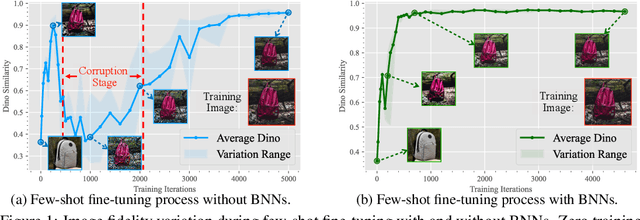


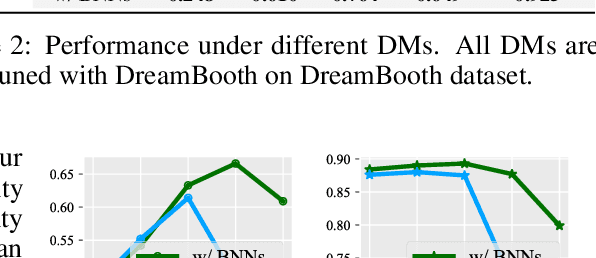
Abstract:Few-shot fine-tuning of Diffusion Models (DMs) is a key advancement, significantly reducing training costs and enabling personalized AI applications. However, we explore the training dynamics of DMs and observe an unanticipated phenomenon: during the training process, image fidelity initially improves, then unexpectedly deteriorates with the emergence of noisy patterns, only to recover later with severe overfitting. We term the stage with generated noisy patterns as corruption stage. To understand this corruption stage, we begin by theoretically modeling the one-shot fine-tuning scenario, and then extend this modeling to more general cases. Through this modeling, we identify the primary cause of this corruption stage: a narrowed learning distribution inherent in the nature of few-shot fine-tuning. To tackle this, we apply Bayesian Neural Networks (BNNs) on DMs with variational inference to implicitly broaden the learned distribution, and present that the learning target of the BNNs can be naturally regarded as an expectation of the diffusion loss and a further regularization with the pretrained DMs. This approach is highly compatible with current few-shot fine-tuning methods in DMs and does not introduce any extra inference costs. Experimental results demonstrate that our method significantly mitigates corruption, and improves the fidelity, quality and diversity of the generated images in both object-driven and subject-driven generation tasks.
CGI-DM: Digital Copyright Authentication for Diffusion Models via Contrasting Gradient Inversion
Mar 17, 2024



Abstract:Diffusion Models (DMs) have evolved into advanced image generation tools, especially for few-shot generation where a pretrained model is fine-tuned on a small set of images to capture a specific style or object. Despite their success, concerns exist about potential copyright violations stemming from the use of unauthorized data in this process. In response, we present Contrasting Gradient Inversion for Diffusion Models (CGI-DM), a novel method featuring vivid visual representations for digital copyright authentication. Our approach involves removing partial information of an image and recovering missing details by exploiting conceptual differences between the pretrained and fine-tuned models. We formulate the differences as KL divergence between latent variables of the two models when given the same input image, which can be maximized through Monte Carlo sampling and Projected Gradient Descent (PGD). The similarity between original and recovered images serves as a strong indicator of potential infringements. Extensive experiments on the WikiArt and Dreambooth datasets demonstrate the high accuracy of CGI-DM in digital copyright authentication, surpassing alternative validation techniques. Code implementation is available at https://github.com/Nicholas0228/Revelio.
SkyMask: Attack-agnostic Robust Federated Learning with Fine-grained Learnable Masks
Dec 19, 2023



Abstract:Federated Learning (FL) is becoming a popular paradigm for leveraging distributed data and preserving data privacy. However, due to the distributed characteristic, FL systems are vulnerable to Byzantine attacks that compromised clients attack the global model by uploading malicious model updates. Most existing Byzantine-robust FL systems statistically analyze the weights of whole individual model updates uploaded by clients to defend against Byzantine attacks. With the development of layer-level and parameter-level fine-grained attacks, the attacks' stealthiness and effectiveness have been significantly improved. Due to unawareness or overreaction, the existing model-level defense methods degrade the training efficiency and model performance. To address this problem, we propose SkyMask, a new attack-agnostic robust FL system that leverages fine-grained learnable masks to identify malicious model updates at the parameter-level. Specifically, the FL server applies parameter-level masks to model updates uploaded by clients and trains the masks over a small clean dataset (i.e., root dataset) to learn the subtle difference between benign and malicious model updates in a high-dimension space. Our extensive experiments involve different models on three public datasets under state-of-the-art (SOTA) attacks, where the results show that SkyMask achieves up to 10% higher testing accuracy compared with SOTA defense strategies and successfully defends against attacks with malicious clients of a high fraction up to 80%. In the meantime, the experimental results demonstrate the scalability of our approach and the weak dependence on the data distribution of the root dataset.
Eliminating Domain Bias for Federated Learning in Representation Space
Nov 25, 2023Abstract:Recently, federated learning (FL) is popular for its privacy-preserving and collaborative learning abilities. However, under statistically heterogeneous scenarios, we observe that biased data domains on clients cause a representation bias phenomenon and further degenerate generic representations during local training, i.e., the representation degeneration phenomenon. To address these issues, we propose a general framework Domain Bias Eliminator (DBE) for FL. Our theoretical analysis reveals that DBE can promote bi-directional knowledge transfer between server and client, as it reduces the domain discrepancy between server and client in representation space. Besides, extensive experiments on four datasets show that DBE can greatly improve existing FL methods in both generalization and personalization abilities. The DBE-equipped FL method can outperform ten state-of-the-art personalized FL methods by a large margin. Our code is public at https://github.com/TsingZ0/DBE.
GPFL: Simultaneously Learning Global and Personalized Feature Information for Personalized Federated Learning
Aug 20, 2023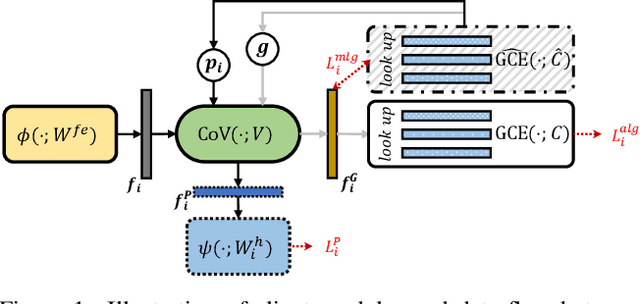
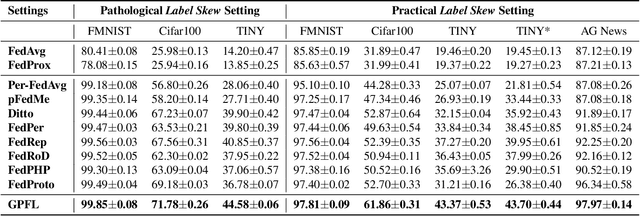
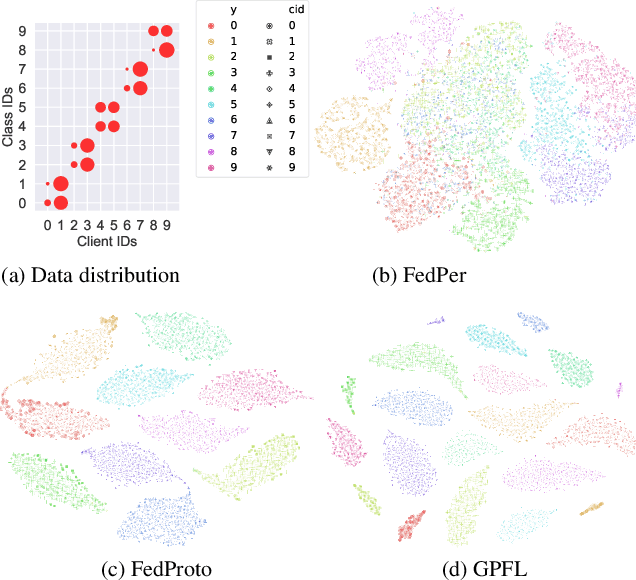
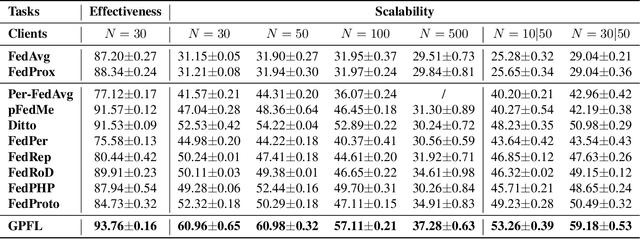
Abstract:Federated Learning (FL) is popular for its privacy-preserving and collaborative learning capabilities. Recently, personalized FL (pFL) has received attention for its ability to address statistical heterogeneity and achieve personalization in FL. However, from the perspective of feature extraction, most existing pFL methods only focus on extracting global or personalized feature information during local training, which fails to meet the collaborative learning and personalization goals of pFL. To address this, we propose a new pFL method, named GPFL, to simultaneously learn global and personalized feature information on each client. We conduct extensive experiments on six datasets in three statistically heterogeneous settings and show the superiority of GPFL over ten state-of-the-art methods regarding effectiveness, scalability, fairness, stability, and privacy. Besides, GPFL mitigates overfitting and outperforms the baselines by up to 8.99% in accuracy.
FedCP: Separating Feature Information for Personalized Federated Learning via Conditional Policy
Jul 01, 2023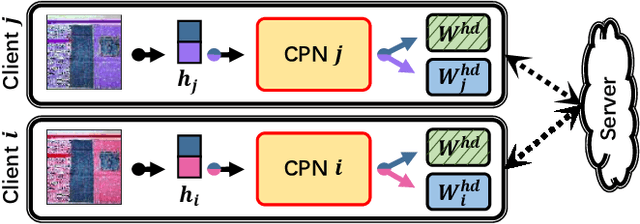



Abstract:Recently, personalized federated learning (pFL) has attracted increasing attention in privacy protection, collaborative learning, and tackling statistical heterogeneity among clients, e.g., hospitals, mobile smartphones, etc. Most existing pFL methods focus on exploiting the global information and personalized information in the client-level model parameters while neglecting that data is the source of these two kinds of information. To address this, we propose the Federated Conditional Policy (FedCP) method, which generates a conditional policy for each sample to separate the global information and personalized information in its features and then processes them by a global head and a personalized head, respectively. FedCP is more fine-grained to consider personalization in a sample-specific manner than existing pFL methods. Extensive experiments in computer vision and natural language processing domains show that FedCP outperforms eleven state-of-the-art methods by up to 6.69%. Furthermore, FedCP maintains its superiority when some clients accidentally drop out, which frequently happens in mobile settings. Our code is public at https://github.com/TsingZ0/FedCP.
 Add to Chrome
Add to Chrome Add to Firefox
Add to Firefox Add to Edge
Add to Edge